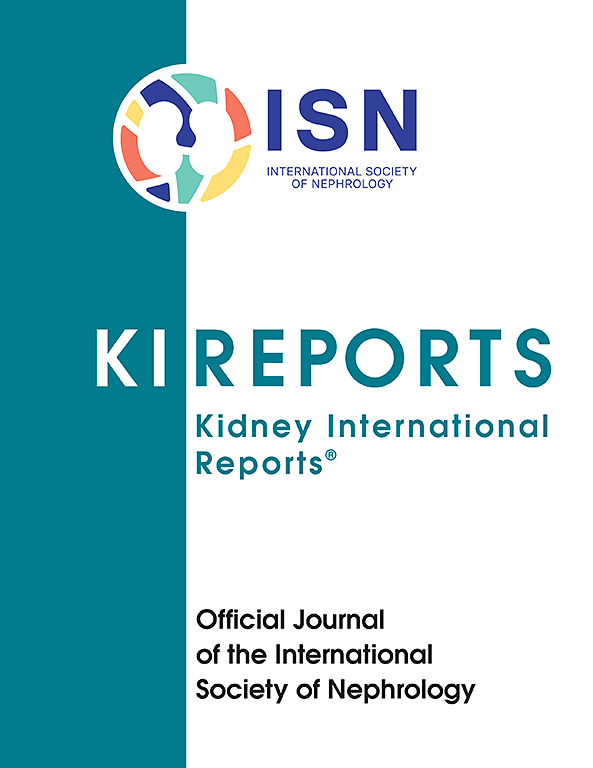The Prevalence and Characteristics of IgA Antibodies to β2-Spectrin and CBX3 in Immunoglobulin A Nephropathy
IF 5.7
2区 医学
Q1 UROLOGY & NEPHROLOGY
引用次数: 0
Abstract
Introduction
In IgA nephropathy (IgAN), the mechanism of IgA-containing immune complexes deposition in the glomerular mesangium had been unclear. We recently reported the presence of IgA antibodies with specificity for mesangial cells (antimesangium IgA antibodies) in sera from patients with IgAN, and identified β2-spectrin (SPTBN1) and CBX3 as target antigens. However, the role of antimesangium IgA antibodies in human IgAN is unclear.
Methods
We measured serum anti-SPTBN1 and anti-CBX3 IgA levels in patients with IgAN (n = 119) and other kidney diseases (disease control [DC], n = 51) using 2 independent cohorts, 1 from Japan and 1 from the UK. The study also assessed the surface expression of the autoantigens on human mesangial cells and the pattern of O-glycosylation of serum anti-SPTBN1 and anti-CBX3 IgA antibodies.
Results
Overall, 30 and 3 patients with IgAN and DC, respectively, had detectable anti-SPTBN1 IgA antibodies (sensitivity, 25%; specificity, 94%); whereas 48 and 3 patients with IgAN and DC, respectively, had detectable anti-CBX3 IgA antibodies (sensitivity, 40%; specificity, 94%). In total, 62 patients (52%) with IgAN had detectable anti-SPTBN1 and/or anti-CBX3 IgA antibodies. The expression of SPTBN1 and CBX3 on the surface of human mesangial cells was confirmed by immunofluorescence (IF) microscopy. Serum anti-SPTBN1 and anti-CBX3 IgA antibodies from patients with IgAN were recognized by an antigalactose-deficient IgA1 antibody (KM55) by Western blotting.
Conclusion
We show that anti-SPTBN1 and anti-CBX3 IgA antibodies are detected with high specificity in patients with IgAN from Japan and the UK, and are enriched for IgA1 with poorly galactosylated O-glycoforms.

免疫球蛋白A肾病中β2-Spectrin和CBX3 IgA抗体的流行及特点
在IgA肾病(IgAN)中,含IgA免疫复合物在肾小球系膜沉积的机制尚不清楚。我们最近报道了IgAN患者血清中存在针对系膜细胞特异性的IgA抗体(抗系膜IgA抗体),并鉴定出β2-spectrin (SPTBN1)和CBX3作为靶抗原。然而,抗血管IgA抗体在人IgAN中的作用尚不清楚。方法采用2个独立队列,分别来自日本和英国,检测IgAN (n = 119)和其他肾脏疾病(疾病控制[DC], n = 51)患者血清抗sptbn1和抗cbx3 IgA水平。本研究还评估了自身抗原在人系膜细胞表面的表达以及血清抗sptbn1和抗cbx3 IgA抗体的o糖基化模式。结果总体而言,IgAN和DC患者分别有30例和3例检测到抗sptbn1 IgA抗体(敏感性为25%;特异性,94%);而IgAN和DC患者分别有48例和3例检测到抗cbx3 IgA抗体(敏感性为40%;特异性,94%)。共有62例(52%)IgAN患者检测到抗sptbn1和/或抗cbx3 IgA抗体。免疫荧光显微镜证实了SPTBN1和CBX3在人系膜细胞表面的表达。免疫印迹法检测抗半乳糖缺乏IgA1抗体(KM55)识别IgAN患者血清中抗sptbn1和抗cbx3 IgA抗体。结论在日本和英国IgAN患者中检测到抗sptbn1和抗cbx3 IgA抗体具有高特异性,并且在半乳糖基化o -糖型较差的IgA1中富集。
本文章由计算机程序翻译,如有差异,请以英文原文为准。
求助全文
约1分钟内获得全文
求助全文
来源期刊

Kidney International Reports
Medicine-Nephrology
CiteScore
7.70
自引率
3.30%
发文量
1578
审稿时长
8 weeks
期刊介绍:
Kidney International Reports, an official journal of the International Society of Nephrology, is a peer-reviewed, open access journal devoted to the publication of leading research and developments related to kidney disease. With the primary aim of contributing to improved care of patients with kidney disease, the journal will publish original clinical and select translational articles and educational content related to the pathogenesis, evaluation and management of acute and chronic kidney disease, end stage renal disease (including transplantation), acid-base, fluid and electrolyte disturbances and hypertension. Of particular interest are submissions related to clinical trials, epidemiology, systematic reviews (including meta-analyses) and outcomes research. The journal will also provide a platform for wider dissemination of national and regional guidelines as well as consensus meeting reports.
 求助内容:
求助内容: 应助结果提醒方式:
应助结果提醒方式:


